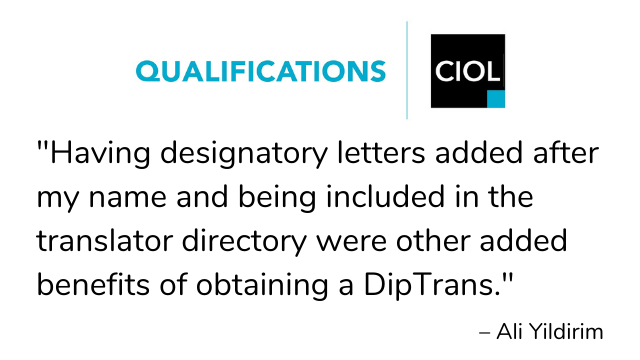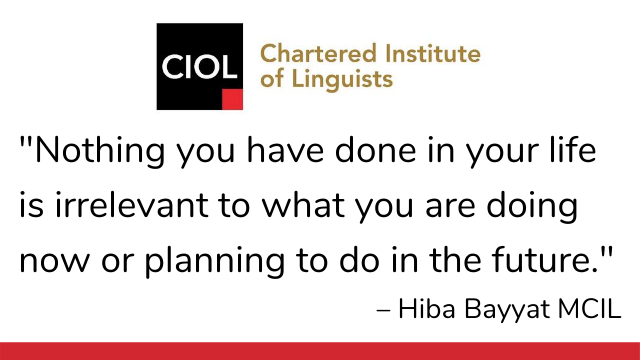-
QUALIFICATIONS
- For Linguists Worldwide
- For UK Public Services
- Preparation
- Policies & Regulation
-
MEMBERSHIP
- Join CIOL
- Professional Membership
- Affiliate Membership
- Chartered Linguist
- Already a member?
- Professional conduct
- Business & Corporate Partners
-
LANGUAGE ASSESSMENTS
- English
- All Other Languages
-
CPD & EVENTS
- Webinars & Events
- CIOL Conferences
- Networks
- CIOL Mentoring
-
NEWS & VOICES
- News & Voices
- CIOL eNews
- CIOL Awards
- The Linguist Magazine
- Jobs & Ads
-
RESOURCES
- For Translators & Interpreters
- For Universities & Students
- Standards & Norms
- CIOL & AI
- All Party Parliamentary Group
- In the UK
- UK Public Services
- Find-a-Linguist
How is technology changing translation work?
by Megan Bowler, Student Affiliate member
Though many translators find it helpful to make use of translation tools as they see fit, the possibility of clients misunderstanding the contributions of these tools can lead to translators being devalued. Responses to the CIOL’s 2021 translation survey indicate that technological developments are changing not only the way translation professionals interact with texts, but also the types of work they receive and clients’ perceptions of their role.
 Unsurprisingly, more translators are using computer-aided translation tools, and 45% of translators surveyed intend to start using a tool in the near future. This is in part due to their increasing quality: 89% of the translators surveyed had noticed improvements in translation technology since they first started using it. Clients’ demands have also contributed to this trend: 76% of translators reported clients mandating the use of translation tools within the past two years.
Unsurprisingly, more translators are using computer-aided translation tools, and 45% of translators surveyed intend to start using a tool in the near future. This is in part due to their increasing quality: 89% of the translators surveyed had noticed improvements in translation technology since they first started using it. Clients’ demands have also contributed to this trend: 76% of translators reported clients mandating the use of translation tools within the past two years.
There are currently a wide range of technological tools available, which include speech recognition software for dictation, spelling and grammar checkers, electronic dictionaries, and glossary databases. Perhaps the technologies with the most significant implications for the translation process itself, however, are translation memories (databases which store previously translated units of text), and machine translation (including engines such as Google Translate).
Translation Memory
 Translation memory (TM) tools are used by an increasing proportion of translators: the survey found that 83% of translators maintained their own translation memory, compared to 65% using translation memory software in the CIOL’s 2016 translators’ survey. TM can boost translators’ productivity by preventing them from redoing the same work, and in the case of shared TM databases, enable them to benefit from each other’s wording or expertise about a particular field.
Translation memory (TM) tools are used by an increasing proportion of translators: the survey found that 83% of translators maintained their own translation memory, compared to 65% using translation memory software in the CIOL’s 2016 translators’ survey. TM can boost translators’ productivity by preventing them from redoing the same work, and in the case of shared TM databases, enable them to benefit from each other’s wording or expertise about a particular field.
However, respondents diverged considerably in their estimations of how transformative TM technology is for their work and the time it saved them. Though more translators working as freelancers and in a wider range of fields are now using TM tools, TM continues to be more relevant for some types of texts than others. For instance, technical, financial and marketing documents are likely to contain more repeating segments than literary content. However, TM tools can still be useful for less repetitious texts, for instance in ensuring consistency in translating terminology and for researching terms and collocations.
Translators today (particularly early-career translators) are generally positive about the benefits of TM; in the 2021 survey, 81% deemed it “a useful tool”. TM can also make translation work more stimulating by enabling translators to skip repetitive groundwork and focus on applying their expertise to achieving semantic precision and fluency.
The main concerns the survey raised about TM technology relate to the increasing pattern of clients employing translators to edit content that has already been through TM programs. 40% of translators surveyed stated that this type of work accounted for more than half of the projects they received. In some cases, clients underestimate the skill and time involved in creating an effective translation from the TM output. They may consequently expect to pay low fees for post-editing jobs, and more generally reduce rates for translators mandated to use TM. Being instructed to use a TM’s matches by default can also stifle a translator’s opportunities to use their own judgement and find innovative solutions.
Machine Translation


44% of translators reported an increase in these ‘post-editing projects’ during the last two years, and the trend applies to clients’ use of machine translation (MT) as well as TM software. MT technology has advanced rapidly in recent years, particularly the developments in neural machine translation; since 2016, Google has used an artificial neural network’s predictions to improve Google Translate. However, MT technology remains fallible, and clients can undervalue the work required to reach a natural translation from MT output. A 2019 study on MT in the context of migration found that, though MT yielded impressively accurate and grammatical results, further editing by translators was essential to correct word-sense shifts and terminological inconsistencies, and to improve syntactic coherence. The study also highlighted the importance of clear guidelines and information from clients for post-editing tasks: those interviewed deemed it crucial to have the original source text to refer to, information about the translation’s context and purpose, and the type of engine used.
Clients and the general public frequently suppose MT technology will ultimately replace the need for human translation. This potential threat to the demand for human translation means that translators, as well as distrusting MT’s reliability, are less positive about MT compared to TM, with 14% surveyed stating that they “wish it did not exist” and 35% deeming it “a necessary evil”.
Both translators and clients would stand to benefit if MT were recognised more accurately as a different type of service to human translation, rather than a near-replacement of it. While basic, instantaneous MT results can undoubtedly suit some purposes, human experts offer many distinctive skills: for instance, in capturing idiomatic expressions, finding creative ways to express intercultural differences, and crafting high-quality prose. Clients unfamiliar with translation, by contrast, may assume it is a kind of word-for-word search for equivalents that lends itself to automation. It is more important than ever, then, to assert the unique qualitative benefits of human translators.
Conclusions
The survey’s findings highlight that translation professionals have had to adapt to significant changes in their field, and are increasingly willing to embrace new tools in their work. However, client demands and the rise of post-editing work can mean that translators do not get to use this technology on their own terms, and are expected to reduce their rates. Accordingly, the expertise that translators offer should be advocated in commercial and industrial contexts. Likewise, translators with experience of such tools are best placed to inform clients on how TM and MT are best utilised and on their own most successful methods of working; increasing knowledge exchange between clients and linguists is crucial.
The responses of translators indicate that technology does not straightforwardly speed up or automate all kinds of translation work: the main reason translators cite for not using tools is the unsuitability of source content (43%). Likewise, many (69%) respondents did not use MT. However, it also emerged in the survey that some translators feel they lack knowledge of how to use computer-aided translation tools, or the time to learn. Increasing opportunities for translators to learn how to use technological tools, both within higher education courses and through translators’ associations, would also enable them to maximise their benefits and make informed decisions.
More
The Chartered Institute of Linguists (CIOL), Incorporated by Royal Charter, Registered in England and Wales Number RC 000808 and the IoL Educational Trust (IoLET), trading as CIOL Qualifications, Company limited by Guarantee, Registered in England and Wales Number 04297497 and Registered Charity Number 1090263. CIOL is a not-for-profit organisation.








